Fibery vs. Aha! What a Beauty!
As the Fibery CEO, I have to switch off the bias. This is hard. Take this post with a grain of salt.
The major goal is to explain how Fibery is different and what strengths and weaknesses it has to support your product development processes. Aha! is the second best tool for product managers on the market (I think Productboard is better, to be honest).
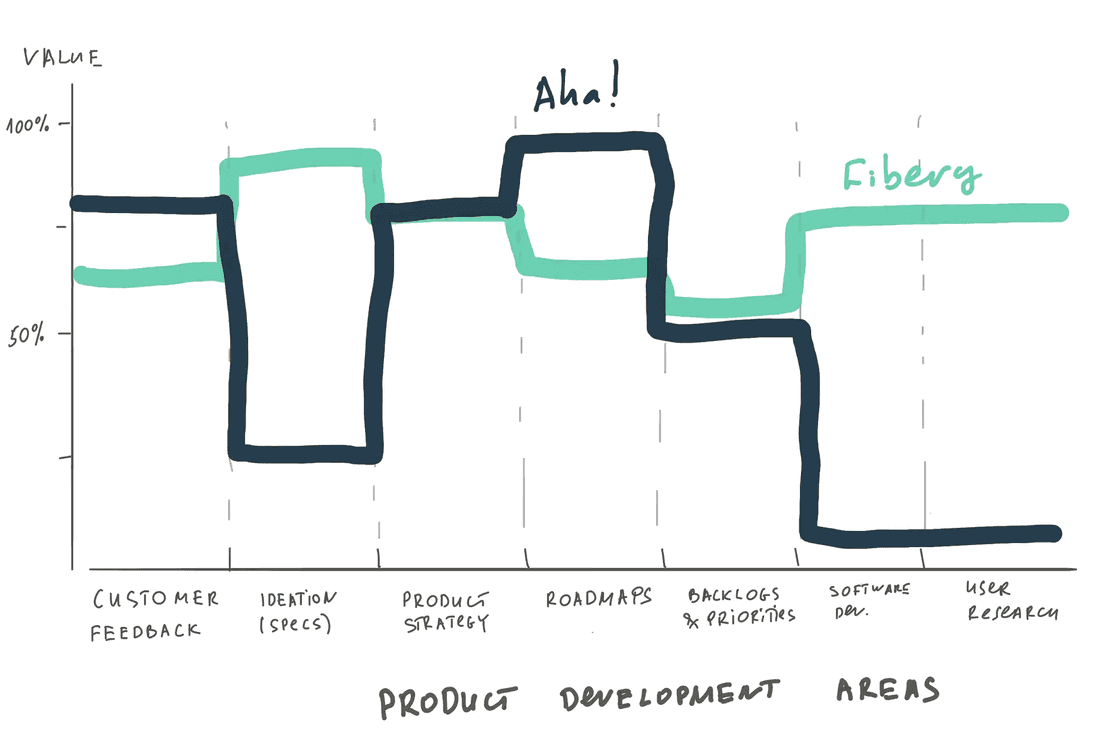
TL;DR
🦕 Aha! is a rich product management software. It works well for strategy definition, backlog management and prioritization, product roadmapping, release management, and ideas management. It lacks ideation, so you’ll have to use external tools to create features specification. It doesn’t support Software Development process, so you will have to use Jira and integrate with it. Like other similar tools, Aha! is opinionated and you can’t change its hierarchy and processes much (but UI is quite customizable though).
Read How Fibery uses Fibery for product development. It’s a good example for a team of 20 people that work on a single product and use Fibery for everything.
🥑 Fibery is more flexible and covers all product development areas. It lacks some depth in roadmapping and release management. It also has fewer integrations. However, you can create beautiful Feature specs in Fibery, run software development process, plan user research studies and connect all information about product development in a single tool.
If you want to focus on product roadmaps, releases, and ideas management — Aha! might be a better choice, it’s a feature-rich tool that nails product management practices. If you want to cover more product development processes and don’t like Gantt charts — Fibery will work better.
Philosophy
Aha! is tailored, but strict
Aha! is a specialized tool for product management. It covers many important product development processes, but not all. Specialization has some benefits and some problems. In general, you can focus on very specific cases and do them right. On the other side, specialization creates narrow tools that are harder to customize and use for other, not designed cases.
It means you have to follow the tool ideology and match it with your internal processes. If the match is 90%, then all is good and you will enjoy the tool. If the match is 70%, then you will suffer in some cases. If the match is below 50%, you will suffer all the time.
🦐 I also want to mention the user interface. Aha! feels complicated and outdated. It is not pleasant to use and there is no aesthetic in it. Let’s say, Productboard is a beautiful piece of software, Aha! is an old workhorse.
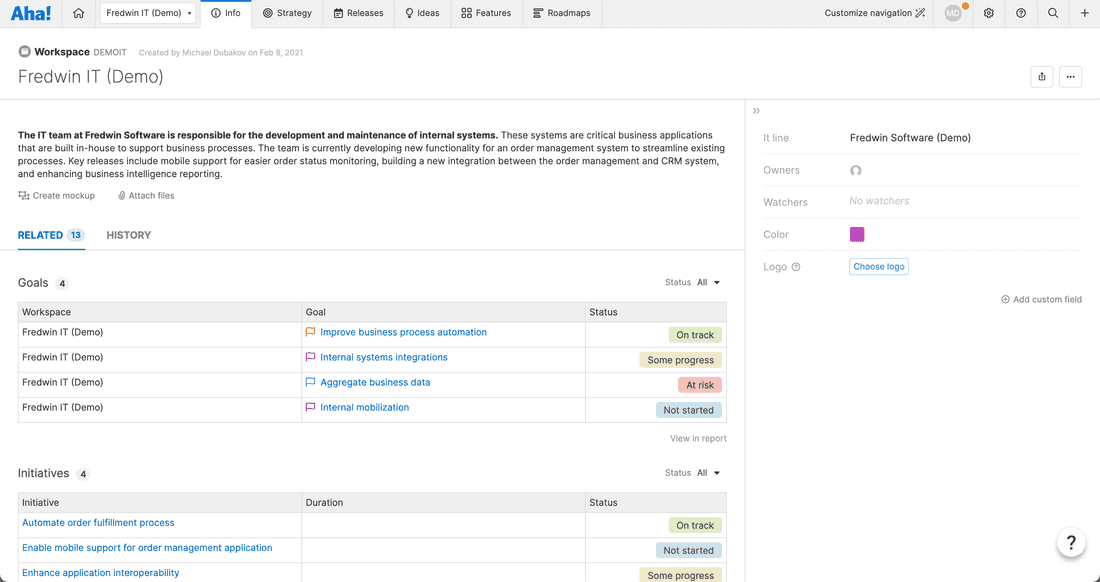
Fibery is generic, but flexible
For example, here is a solution for product management processes.
Fibery is a no-code tool at its core. It means in theory you can construct a solution for many processes.
The benefit is customizability. You can change the tool as you wish: add processes, remove processes, connect processes, customize processes and create a solution that fits your company.
The downside is that some specific cases might be less usable than in specialized tools.
Now we’ll focus on specific product development processes and compare Aha! and Fibery for every process.
Customer Feedback handling
Customer needs drive product development and helps build great products. You should listen, aggregate feedback from all possible sources into a single place, and use the feedback for decision-making about the product’s future.
💪 In Aha! you can collect Ideas from Feedback Portal. It’s very similar to other tools, people can submit ideas, vote for them, discuss them and track Ideas status. This part looks good:
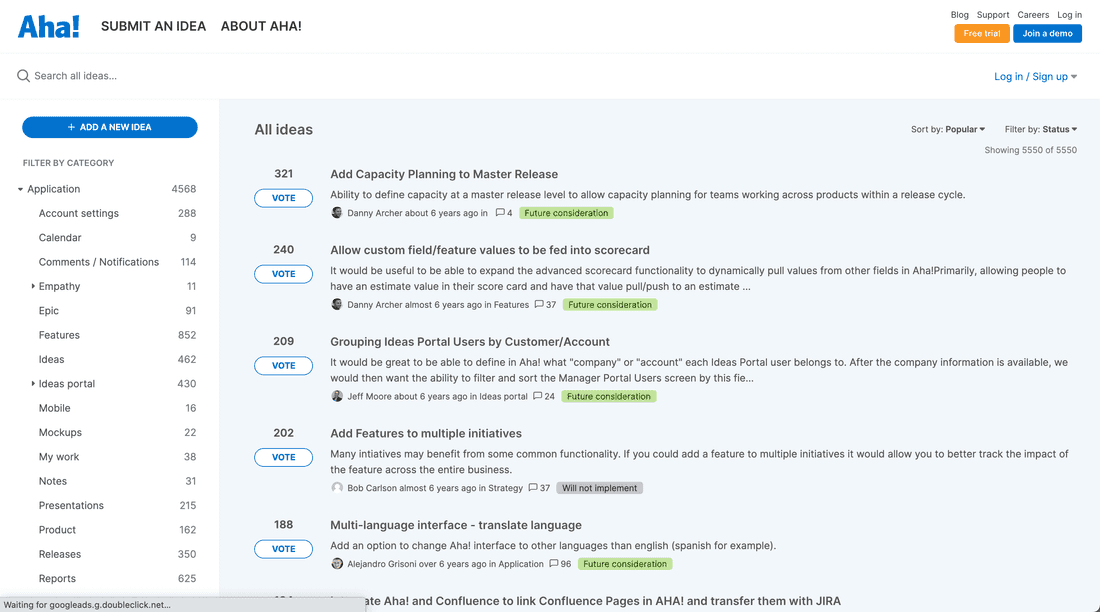
Inside Aha! you can see all the Ideas, comment on them, promote Ideas to Features, etc.
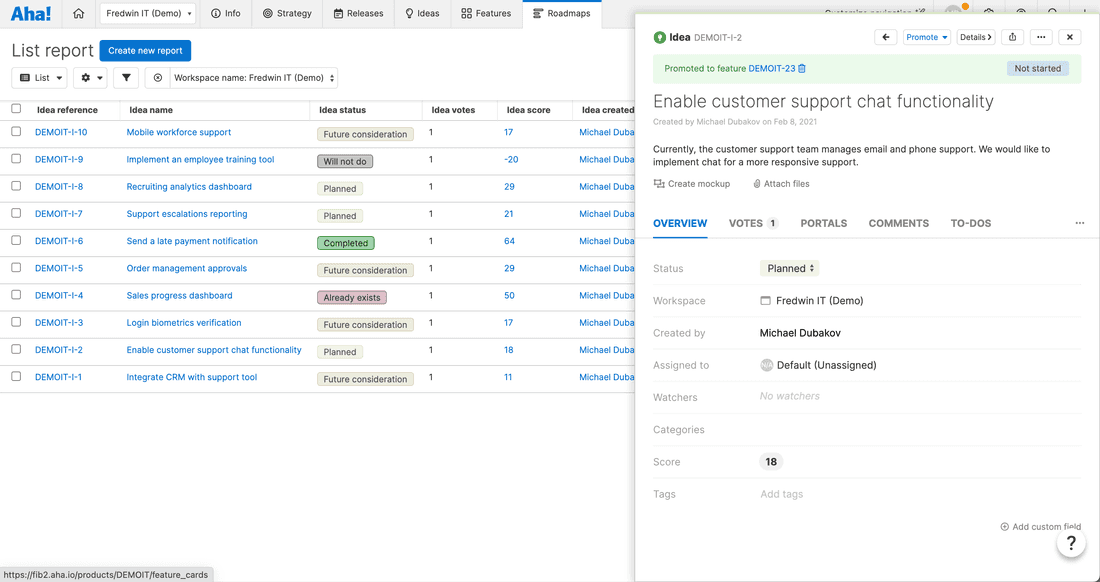
Aha! can intake feedback from Zendesk and Salesforce, but there is no integration with Intercom, which is very popular. It also looks like they are not adding more connectors these days, the idea is like 5 years old already. Also, there is no easy way to capture feedback from calls, meetings, and customer discovery sessions.
💪 In Fibery you can capture feedback from external sources, like Intercom and Discourse. There is a flexible feedback linking mechanism, where you just highlight any sentence in a chat, meeting notes and link this piece of feedback to Insights, Ideas, Features, Tasks, Bugs and whatever you want:
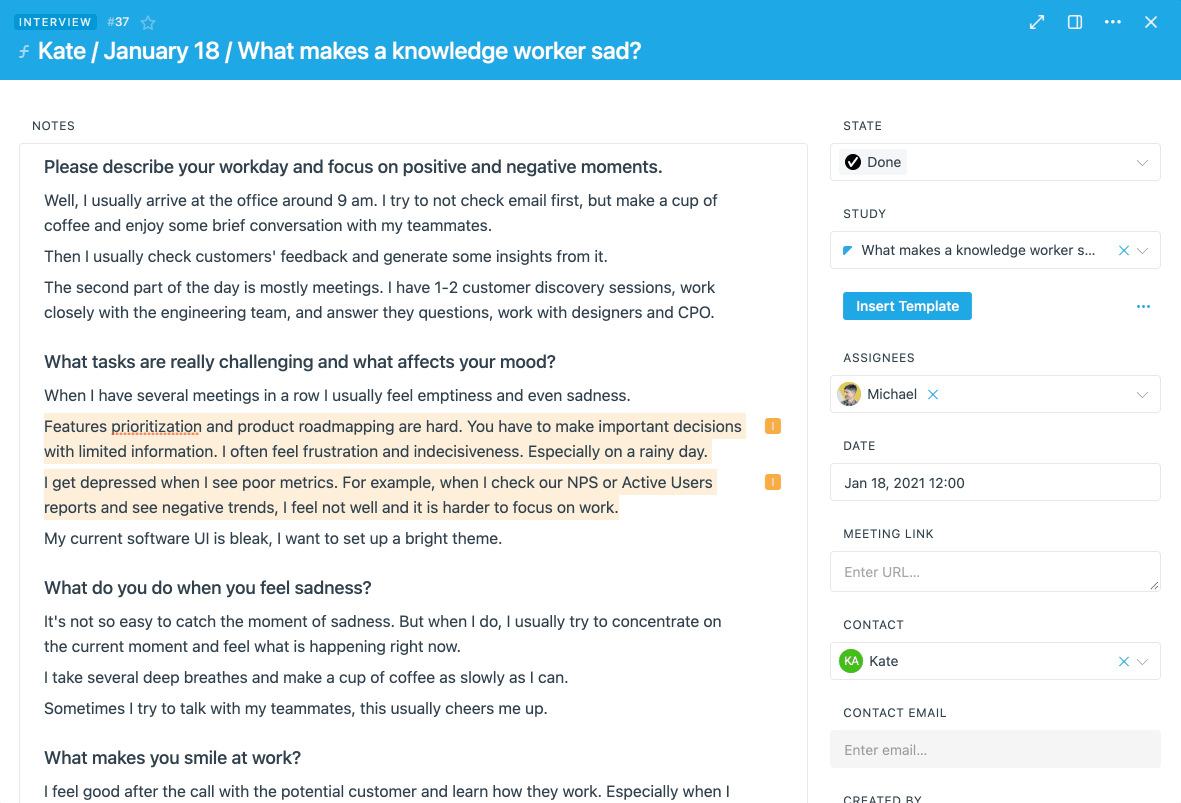
Capture feedback from conversations or Intercom and create Insights
You can also track Insights independently, collect more feedback, think and only then decide whether it worth to be implemented.
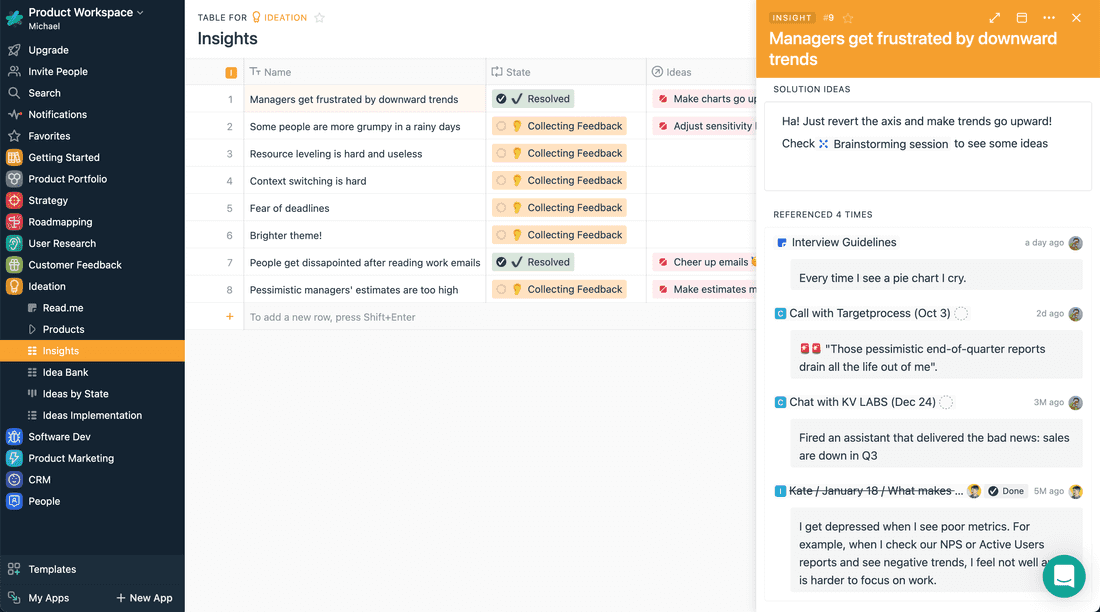
🦐 However, Fibery has no Portal to collect feedback. That’s a weakness.
Ideation: Features specification
Ideation is very important for product development. Usually, it’s handled via Documents and Whiteboards. For example, you use Google Docs and Miro. In the ideal world, you store ideas, brainstorming sessions, and feature specs in a single place. It’s great to have the whole product vision connected to plans and features.
🦐 In Aha! you can create features specifications, but it looks weird, to be honest. You have to split every Feature into a set of Requirements to put meaningful information inside, but from my personal experience, it’s much better to just write a single document as a feature specification.
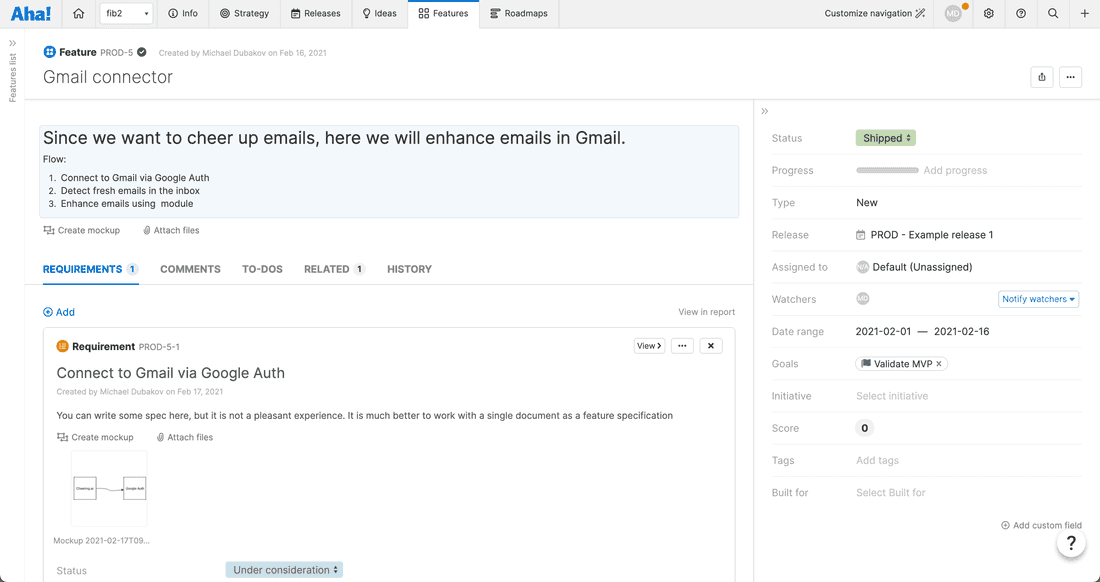
The same things apply to Ideas, Epics, etc. It’s not a very pleasant experience to create specifications. Moreover, it’s not collaborative, so you can’t work on a spec together via some kind of session.
💪 On the positive side, you can create diagrams via draw.io, it’s integrated into the Aha! and it’s easy to discover.
💪 Fibery takes ideation very seriously. You can create collaborative Feature specifications and Whiteboards. Editing capabilities are quite powerful, you can comment inline, insert whiteboards, and links to other entities into specifications.
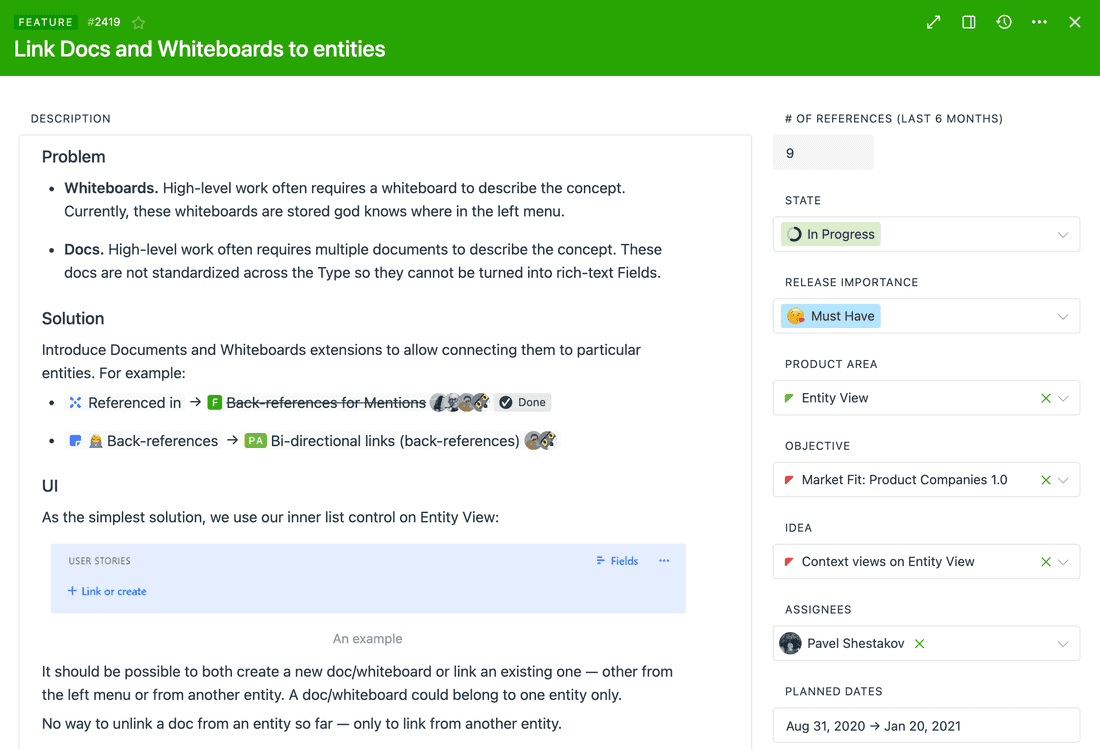
Whiteboards in Fibery are pretty powerful and tightly integrated, which means you can link them to Features or other entities, create Features from diagrams on the fly. Usually, you use a separate tool for that, but having everything in a single place is just so much more enjoyable.
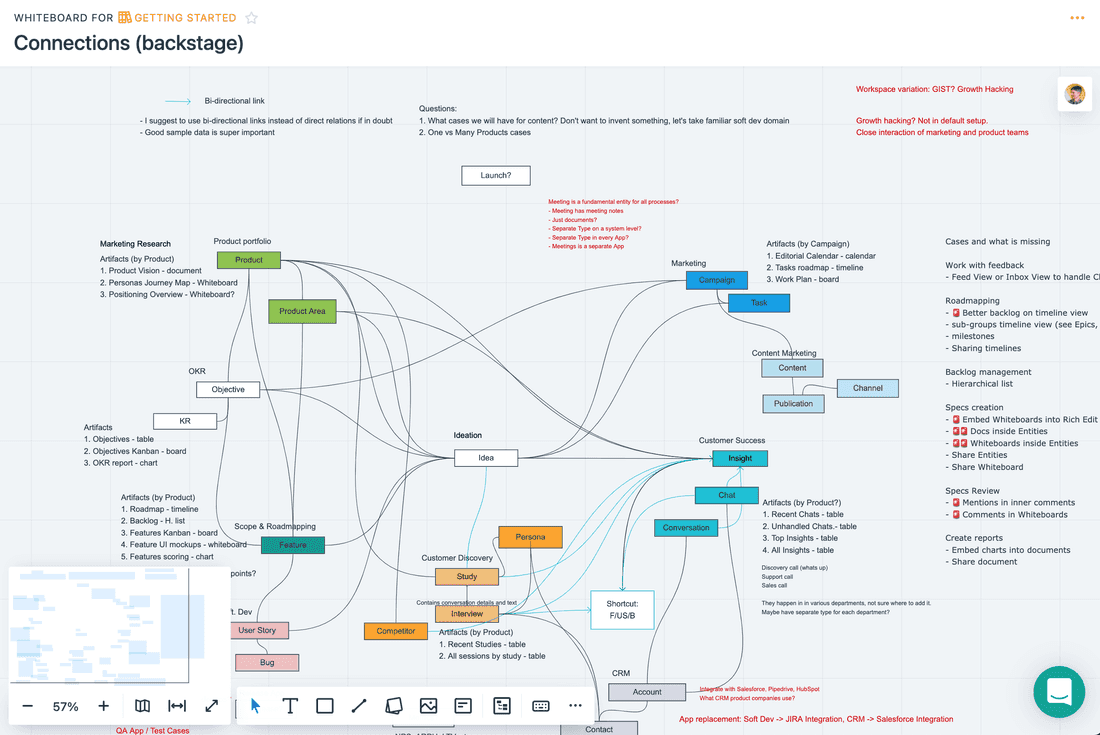
Product Strategy
Product strategy defines what we implement in a product. It’s always a good idea to link product strategy to execution and see what features we implement to meet objectives and goals.
In Aha! There are Goals and Initiatives. You can define Goals for the product and link Initiatives, Features, and Releases to the Goals. All is good. However, you can’t define Key Results. So if you want to use OKR for Goals, it will be harder to do.
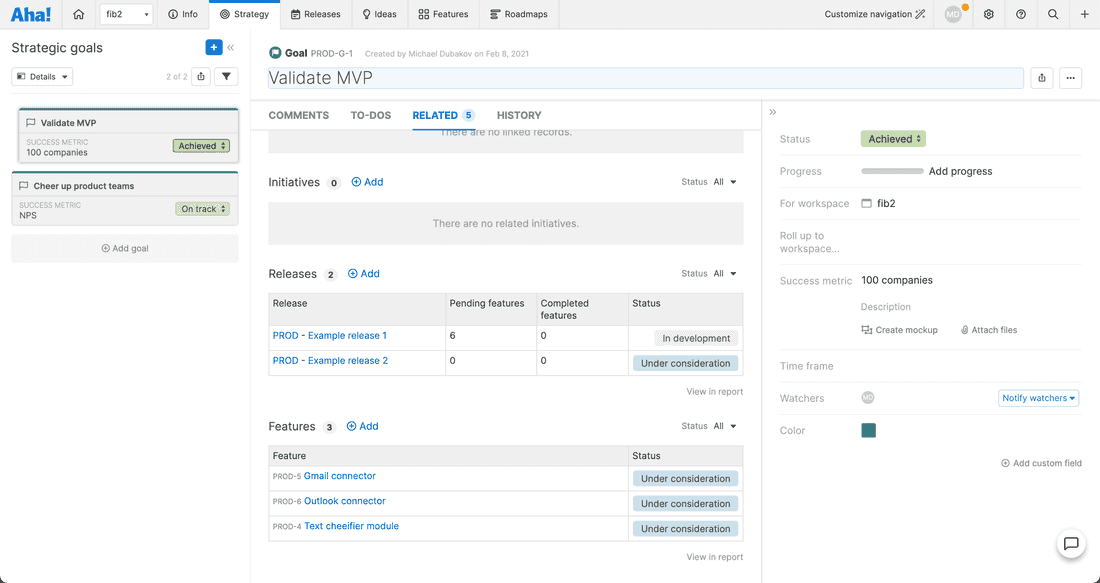
In Fibery Strategic planning is more flexible. You can create Objectives for any Product, create Key Results, link Features/Initiative/Marketing Campaigns to Objectives, and track Objectives’ progress as well.
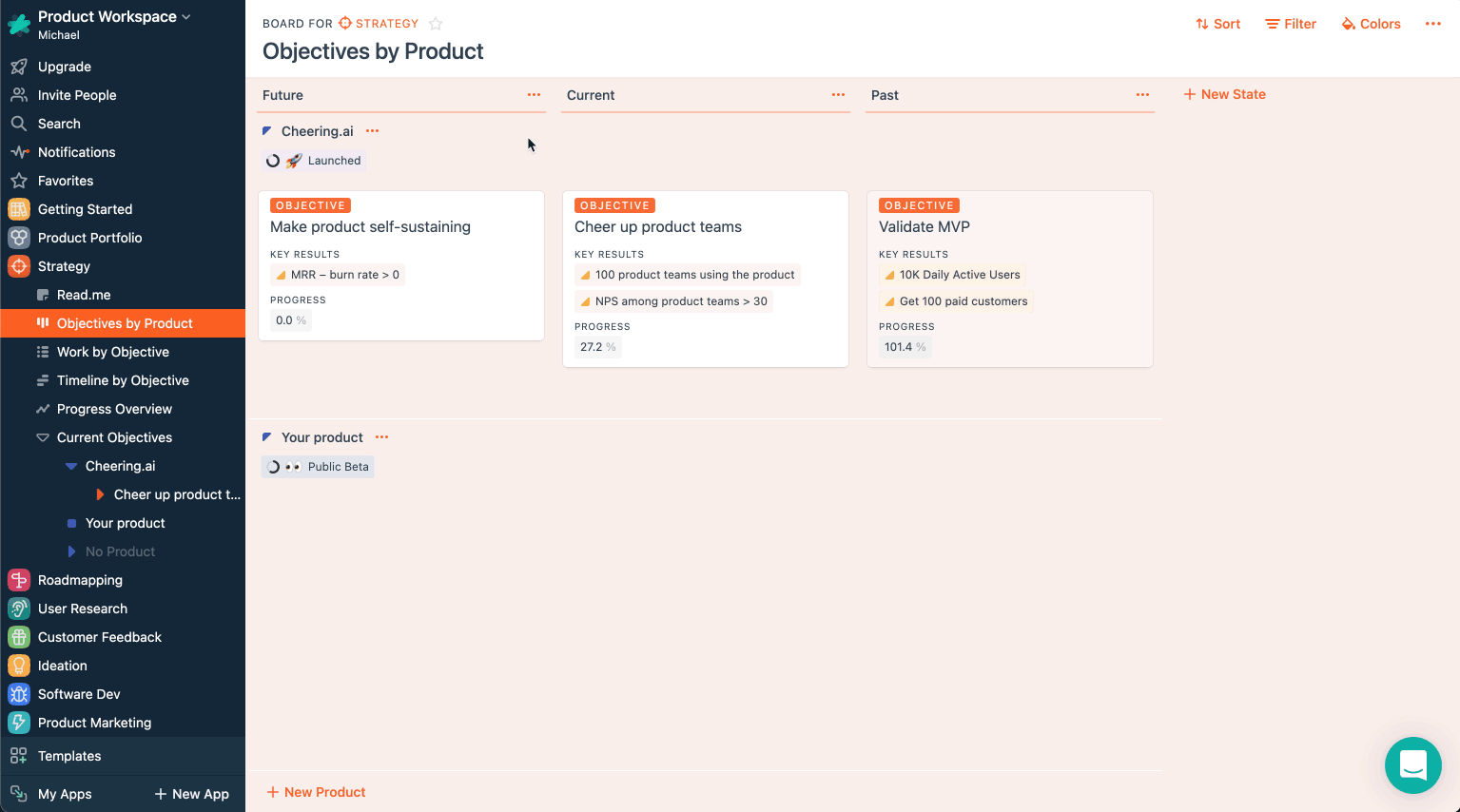
Set Objectives for Products, see them on a Kanban board, track Objectives progress.
Overall, I’d say there is no big difference, but if you want to track Goals differently, there is no way to do it in Aha!
Product Roadmapping and Planning
Features prioritization is one of the hardest problems in product management. Usually, some formal model works better than manual prioritization. You also should quantify customers’ feedback and include it in the model.
Aha! does not have a special screen for backlog management, so you do it on a board with all Features assigned to releases. It works, but still, sometimes you want to focus on a backlog and here it’s not so easy to do. As for metrics, scoring in Aha! is quite advance and you can set custom formulas to calculate Feature importance.

💪 A nice addition is Story Map screen where you can define flows of different personas, create Epics and Features, and assign them to releases.
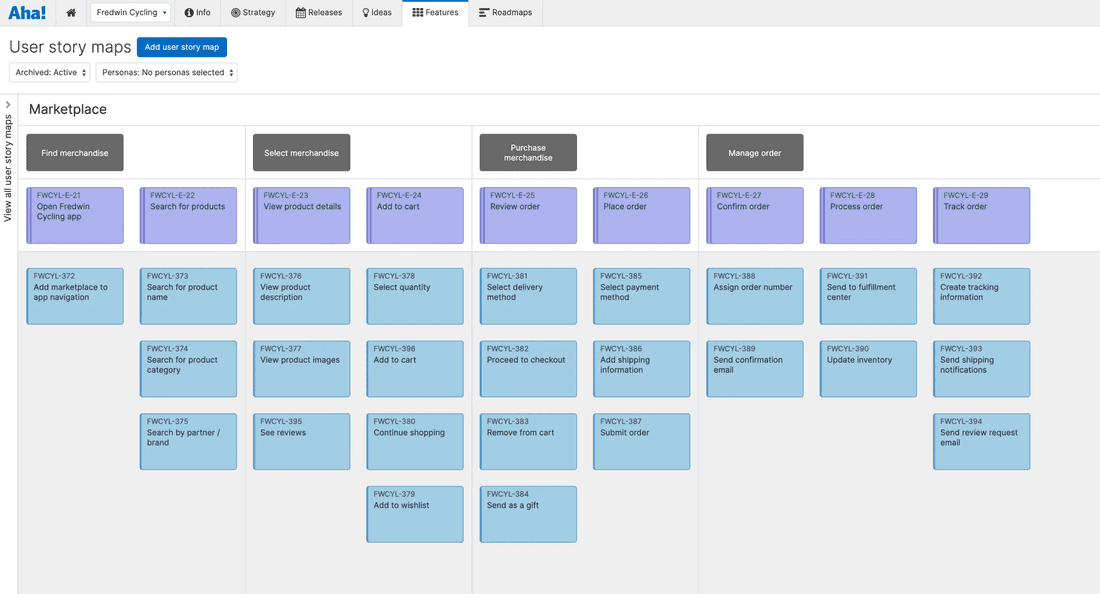
💪 Roadmaps in Aha! are Gantt charts. You can see all features, set dependencies, and do all the things. By default Aha! promotes release phases, and it looks very waterfallish to me.
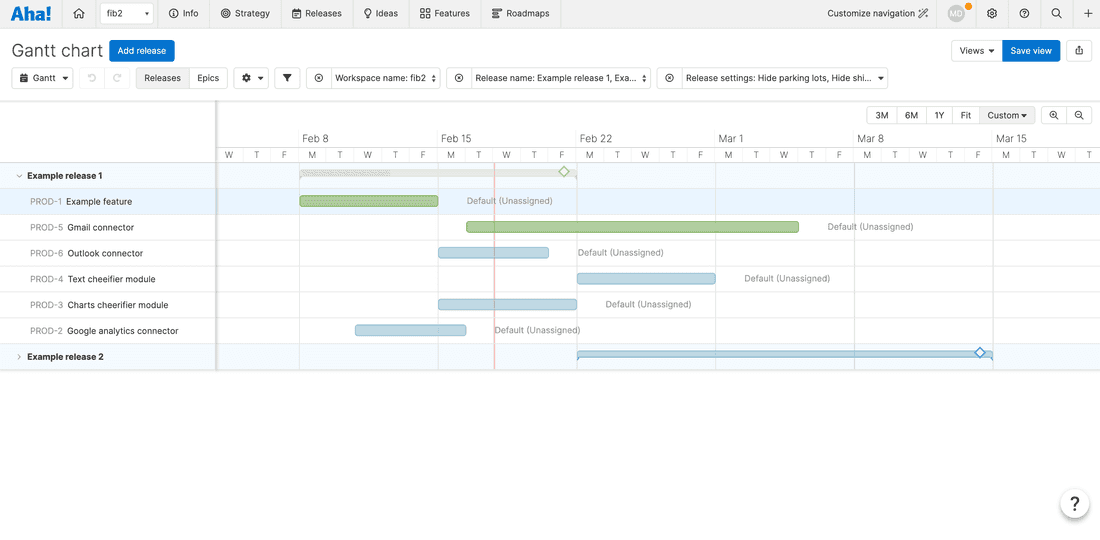
Prioritization is very powerful in Fibery, you can create custom scoring formulas. For example, RICE formula looks like this in Fibery:
((Reach * Confidence.Value) * Impact.Value) / Effort
In Fibery backlog management is very similar. You can do it on a board view, or you can have a table with all not-started features ranked by custom metric.
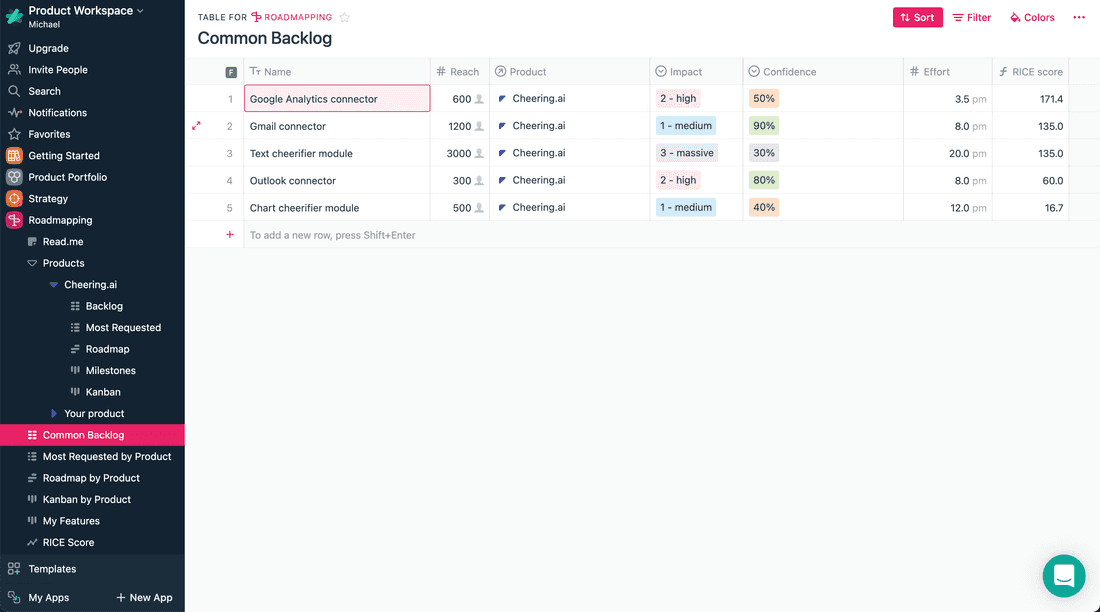
🦐 Roadmaps in Fibery are less advanced. For example, there is no way to visualise dependencies or see milestones. However, Roadmap here is not a Gantt chart, so it looks less waterfalish and information density is higher.
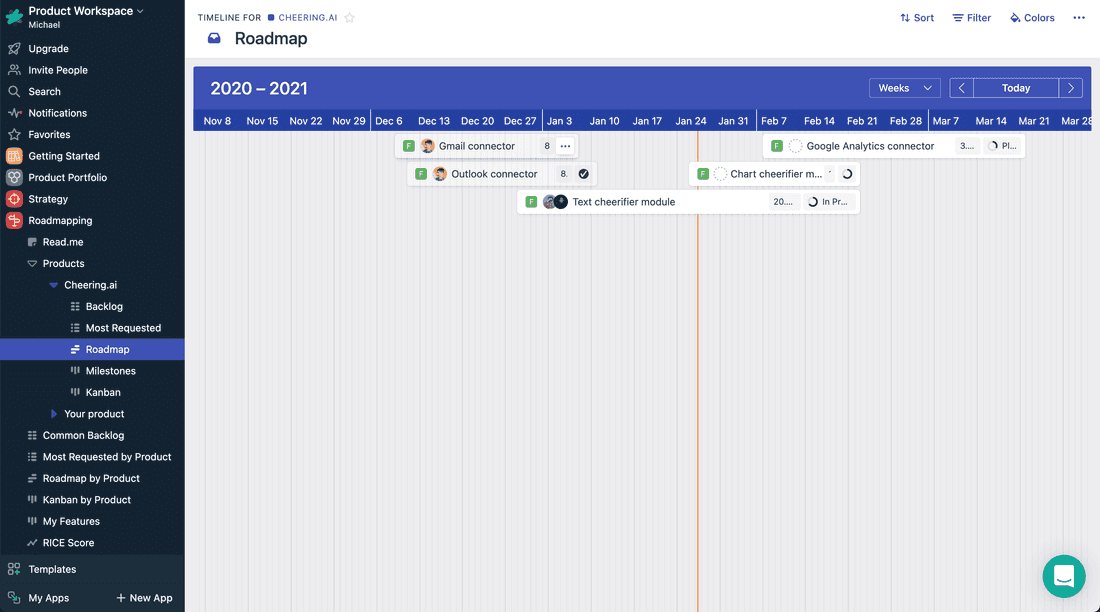
Software Development
🦐 In Aha! you can’t track software development but have to use some external tool, like Jira and Trello. Luckily, Aha! has many integrations: Jira, Bugzilla, Trello, Asana.
The problem here is silos. Silos are bad for cross-functional teams. Suddenly developers have a hard time seeing real Features or Objectives or even see real customers’ feedback related to these Features. It is hard to split features into User Stories and keep product management and software development in sync. In general, this is a deep philosophical problem: specialized tools reinforce silos inside a company where information flows are impeded by artificial obstacles and this can lead to poor decisions. Integration solves this problem partially, but this is just a workaround to alleviate some pain.
💪 In Fibery you can do both. You can connect Jira or Trello, but the best way is to track software development right in Fibery. It’s more powerful than Trello and in most cases good enough to replace Jira.
Fibery supports Scrum and Kanban processes, so you can define Sprints, split Features to User Stories, estimate them and execute Sprints. You can also define your own agile process.
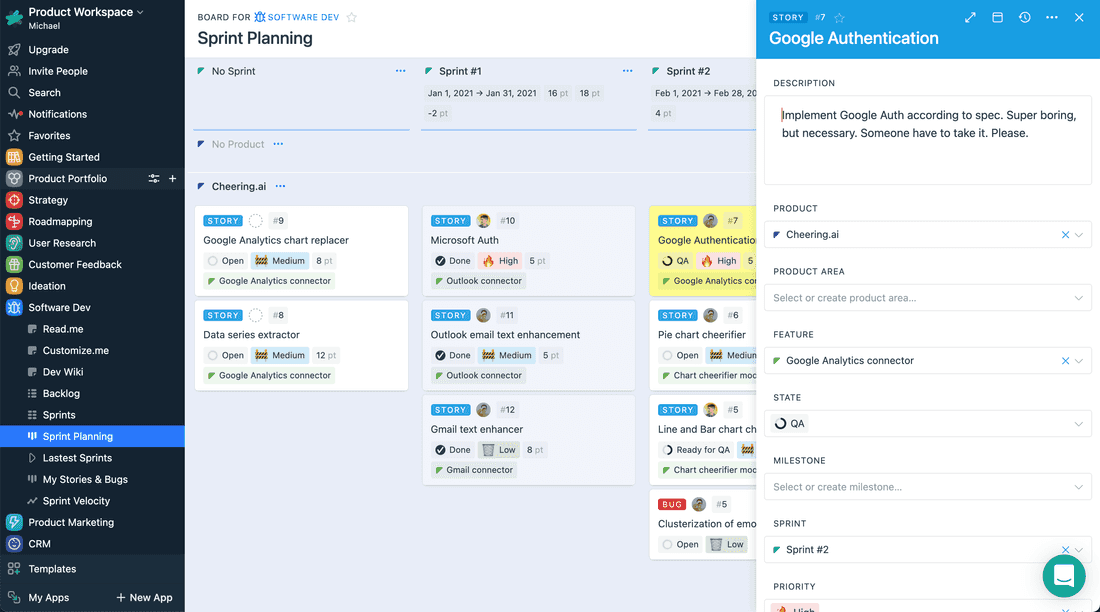
The great thing is that Bugs and User Stories are connected to Features, so you can easily trace execution level as a product manager, or check actual Feature details and feedback as a developer.
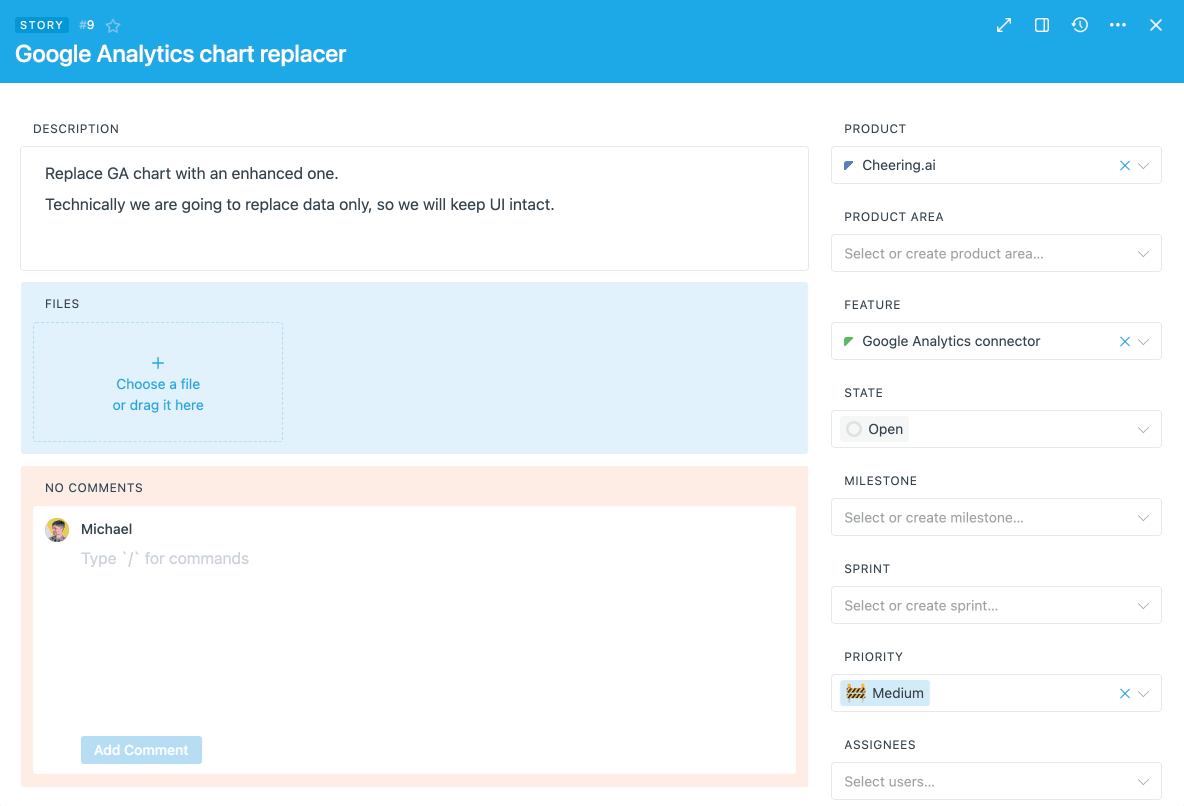
Navigation between Stories, Features and Ideas in Fibery.
You can also set up GitLab or GitHub integration and link Stories/Bugs/Tasks to Merge Requests.
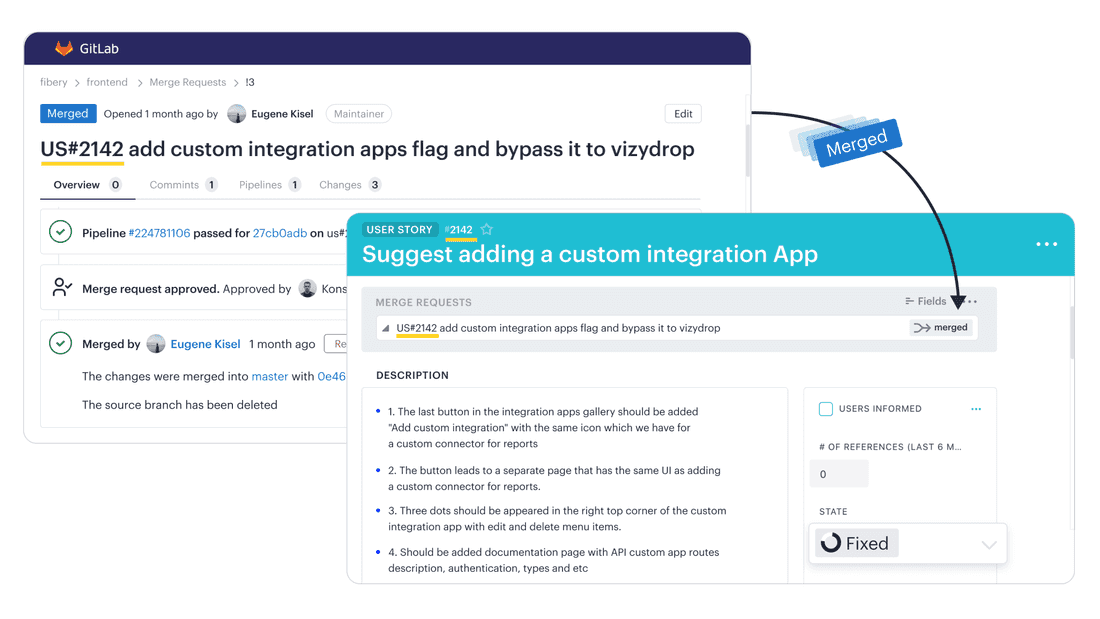
User Research
When you want to learn something about your potential customers, you have to be proactive and do user research: define user persona, plan studies, run interviews, document results, and capture highlights. This is one more way to have useful feedback and build something viable.
🦐 It’s not possible to plan and run user research in Aha! You have to use some external tool like Dovetail or Google docs. It means insights from such sessions are harder to connect to Ideas and Features.
💪 In Fibery there is a separate App to plan, execute and analyze User Research studies.
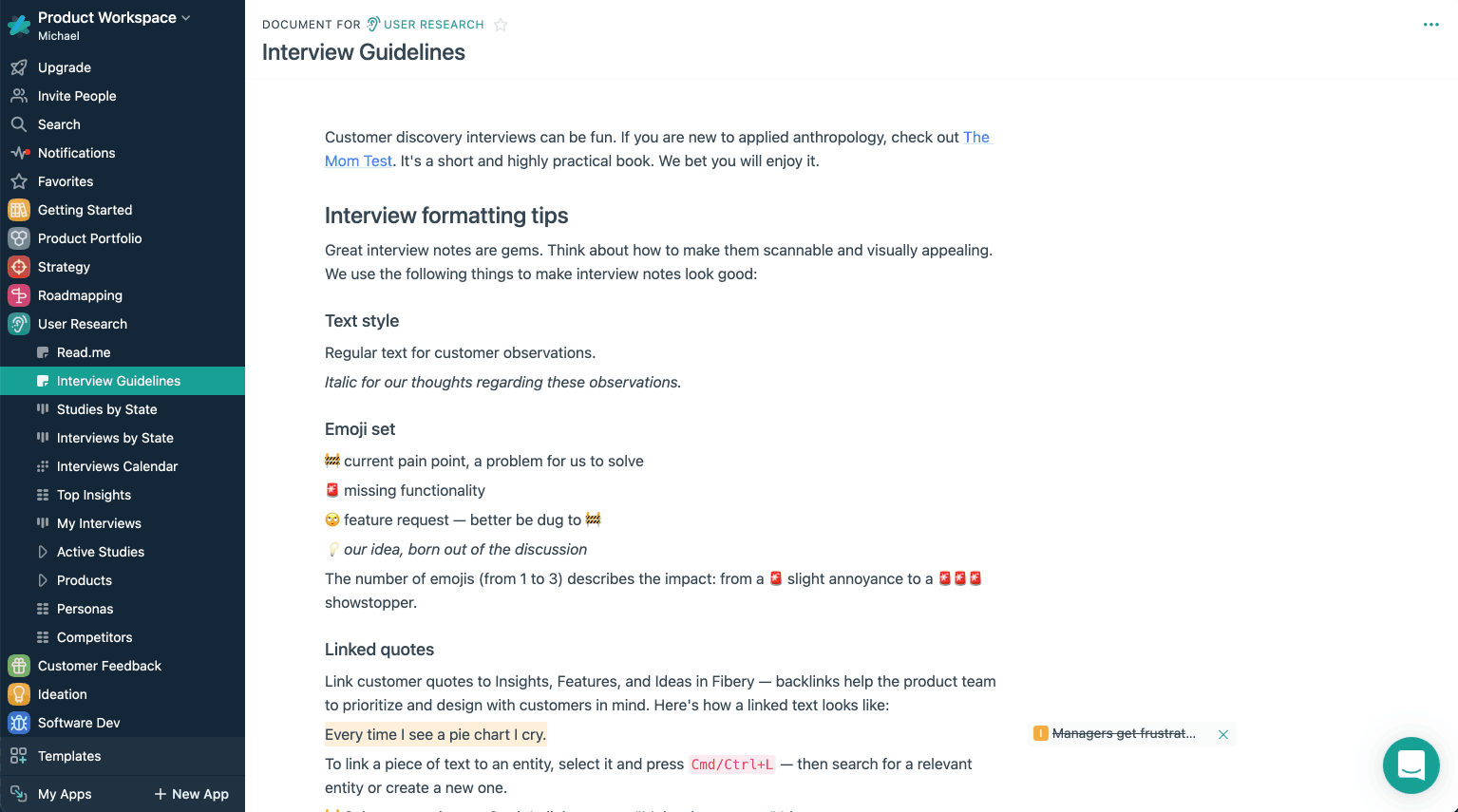
Organize user research studies, capture meeting notes and insights, link them to features and ideas.
Connectivity
Information connectivity defines information quality in some way and allows people to explore information much more easily. Imagine what happens when everything is disconnected, like there are no links between feedback and features, between objectives and work, between insights and ideas. Suddenly you have a hard time understanding why some particular feature is on top of the backlog, or why we implement these 5 tasks.
In Aha! connectivity is OK. You can link important things in a defined domain: Goals to Initiations and Features, Ideas to Features, etc. However, there is no freedom here. You can’t, for example, connect part of the feedback to some Feature.
💪 In Fibery connectivity is the core. You can flexibly set relations between all entities and thus form a complete product knowledge graph in a single tool:
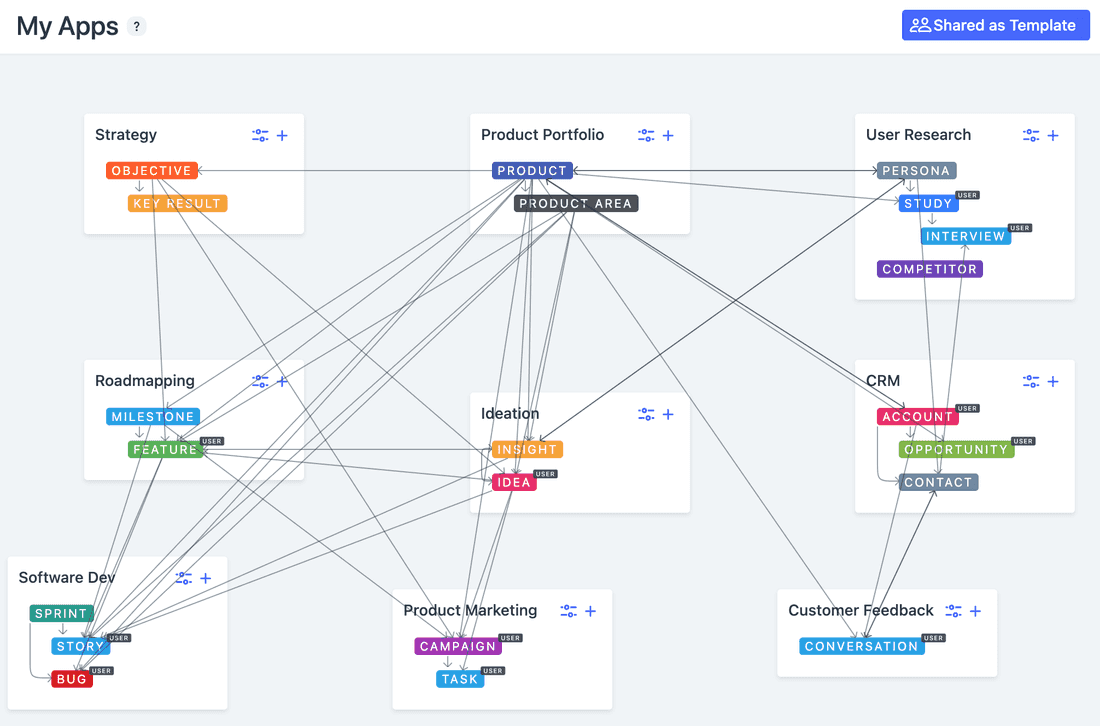
Customizability
Companies are different and every company has a unique set of product management processes. It’s hard to create a tool that fits many companies in fact. There are two polar ways to attack the problem:
- Create a specialized tool and add some customization options
- Create a generic tool and add some specialized features
Aha! follows the first approach. It has some customizability built-in, but not so much in fact (mostly UI). There is no way to reflect company structure like Department → Teams. There is no way to add Key Results to Goals, for example.
💪 Fibery follows the second approach. It’s a LEGO, so you can create your own Apps and fine-tune them to your needs. You can add custom Types (Epics, Initiatives, Teams, etc). You can connect them as you wish. You can create custom Views to visualize information as a Board, Table, Timeline, Calendar, or Report. You can create a product marketing app, team retrospective app, CRM app, project management app, etc.
Extensive customizability comes with a cost — Fibery is not so easy to grasp. When everything is hardcoded you have to learn the structure once and get used to it. When everything is flexible you can change the structure and the learning process never stops.
However, in the long run, this pays off. Every company is not fixed. It grows, changes and adapts. Fibery can accommodate the changes and change itself, Aha! will have a hard time keeping up.
API & Integrations
Aha! API has great REST API. You can all you need.
💪 Aha! has more integrations and they are pretty useful: Jira, Zendesk, Slack, GitHub, etc.
Fibery has a weird, but powerful API. You can create databases and build your own schema using API, and definitely, you can do pretty advanced queries and create entities. Webhooks are there as well.
Fibery has fewer integrations, but they are pretty useful too.
Fibery has GraphQL API that is very easy to use.
Summary
Let’s compare strengths 💪 and weaknesses 🦐 in Fibery and Aha!.
Fibery
---
💪 Feedback linking to Features, Ideas, Bugs, and anything you want
🦐 No Ideas Portal
💪 Ideation: collaborative docs and whiteboards to create specs
🦐 Less advanced roadmapping
💪 Software development process support (Scrum, Kanban, your own)
💪 Charts are really powerful
💪 User Research process is there
💪 Extensive connectivity between all processes
💪 Extensive customizability, since Fibery is a no-code tool in its core
🦐 Not so many integrations
Aha!
---
🦐 User interface looks outdated and not crafted.
💪 Feedback collection from Zendesk & Salesforce
💪 Ideas Portal
🦐 Poor Ideation: Features specification are limited
💪 Product Roadmapping and Planning is good
💪 Custom prioritization schemes
💪 Story mapping
💪 Release management is very advanced
🦐 No Software development process
🦐 No User Research process
🦐 Domain is hardcoded and impossible to change
💪 Integrations are quite good 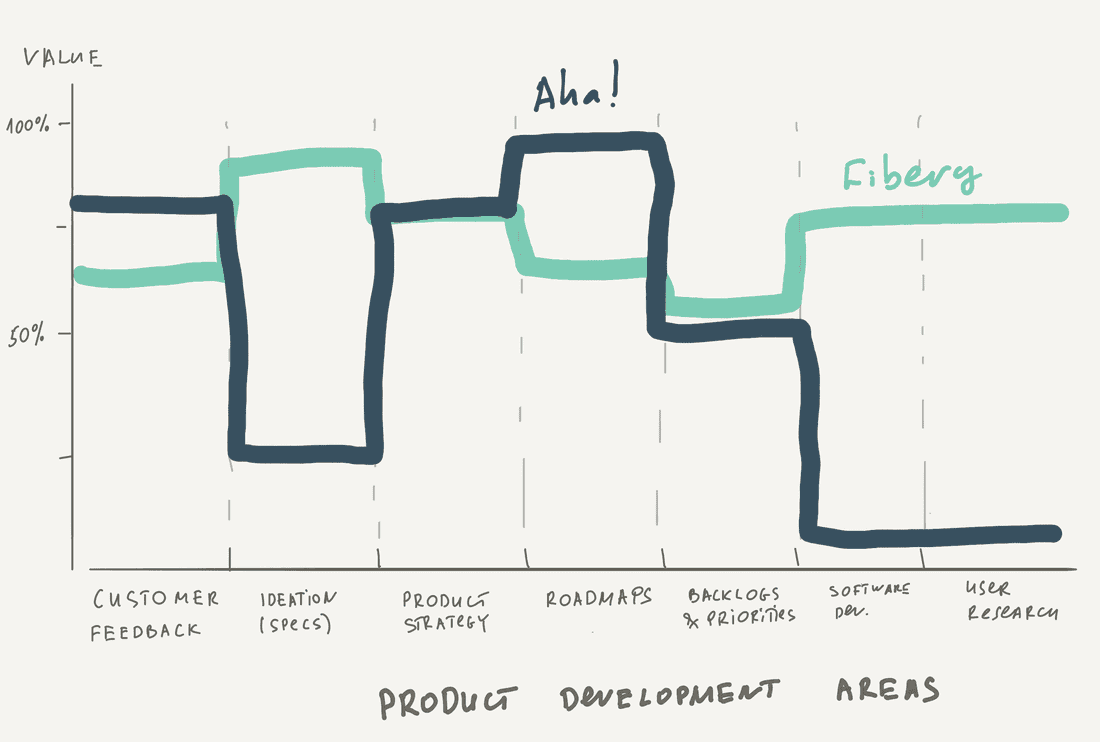
Psst... Wanna try Fibery? 👀
Infinitely flexible product discovery & development platform.